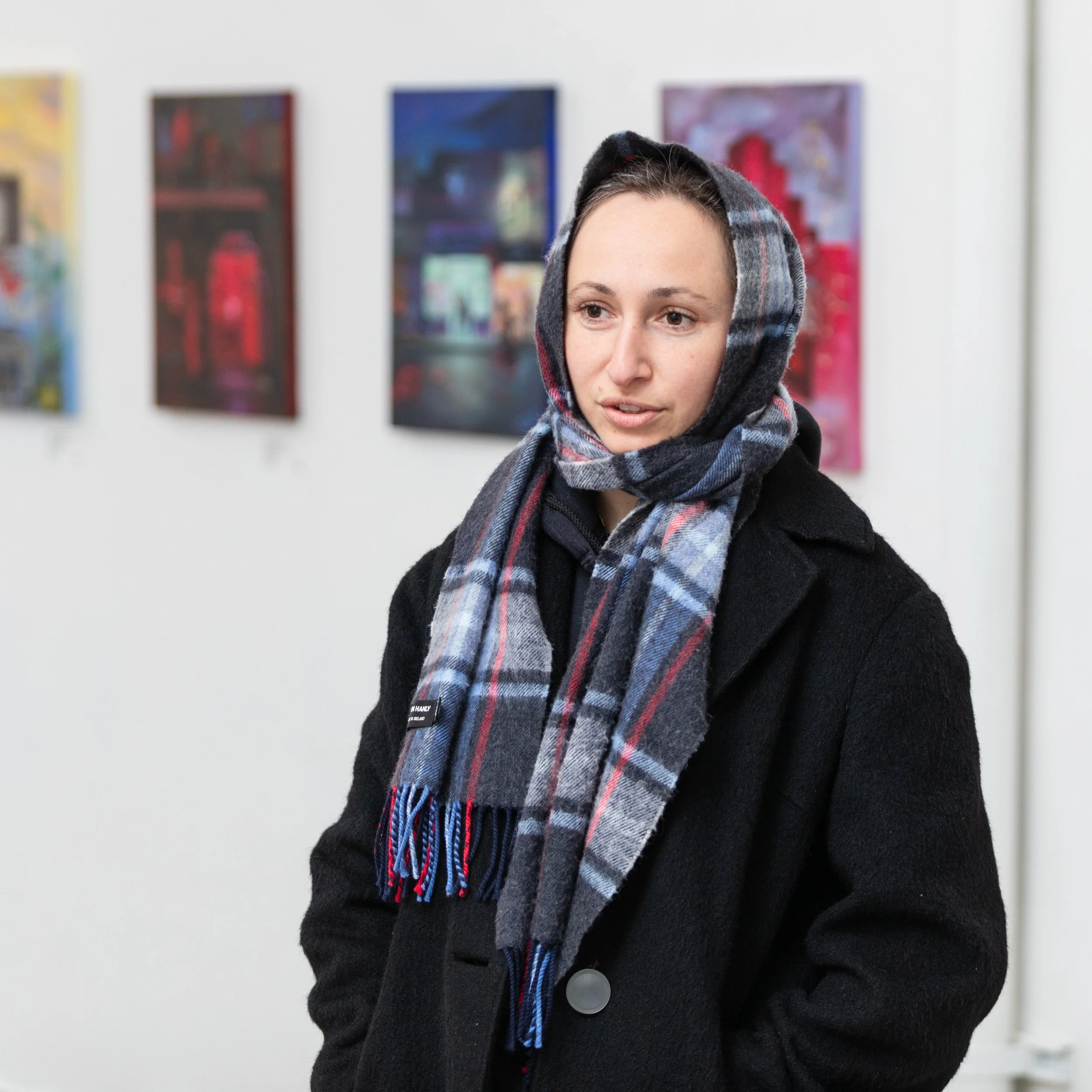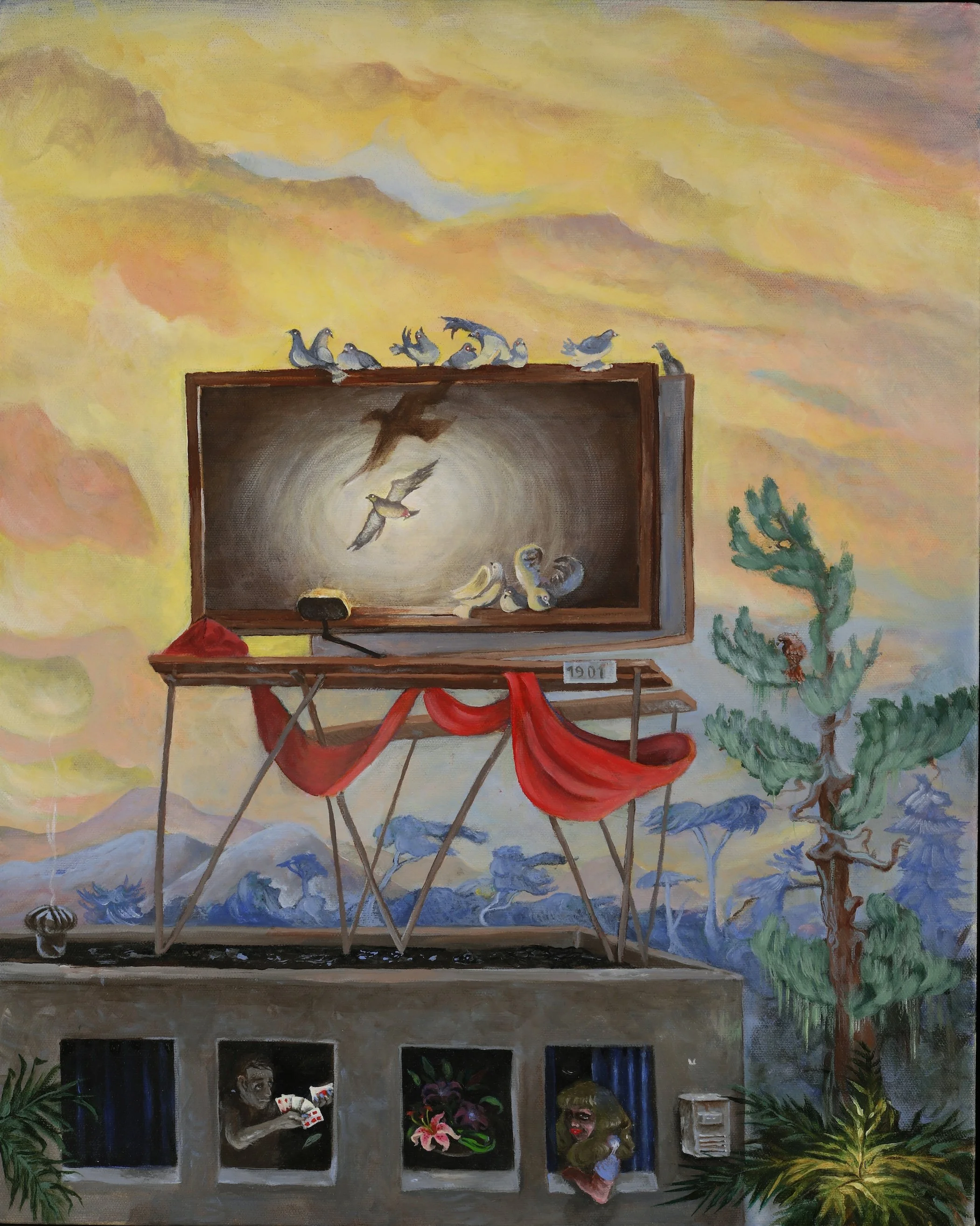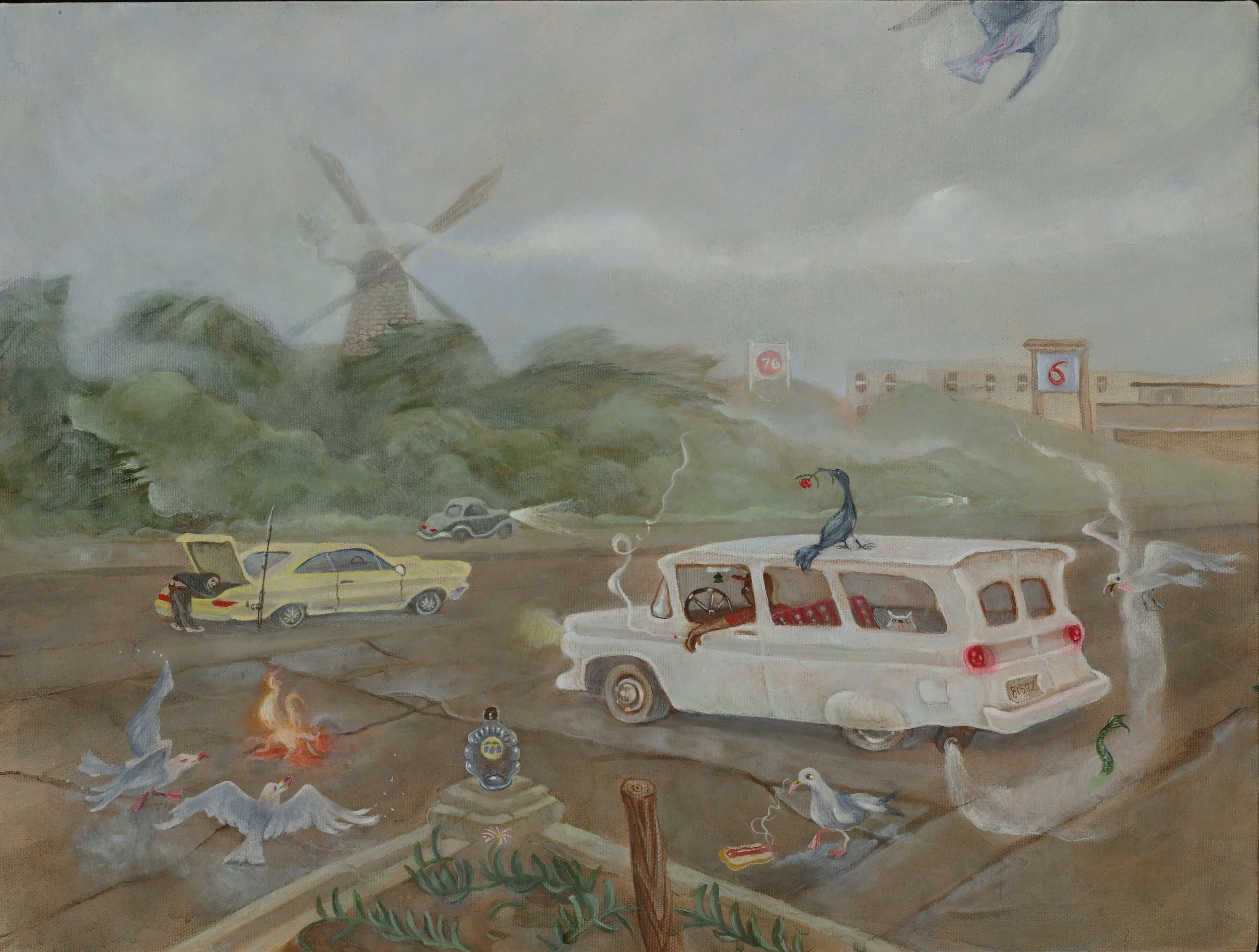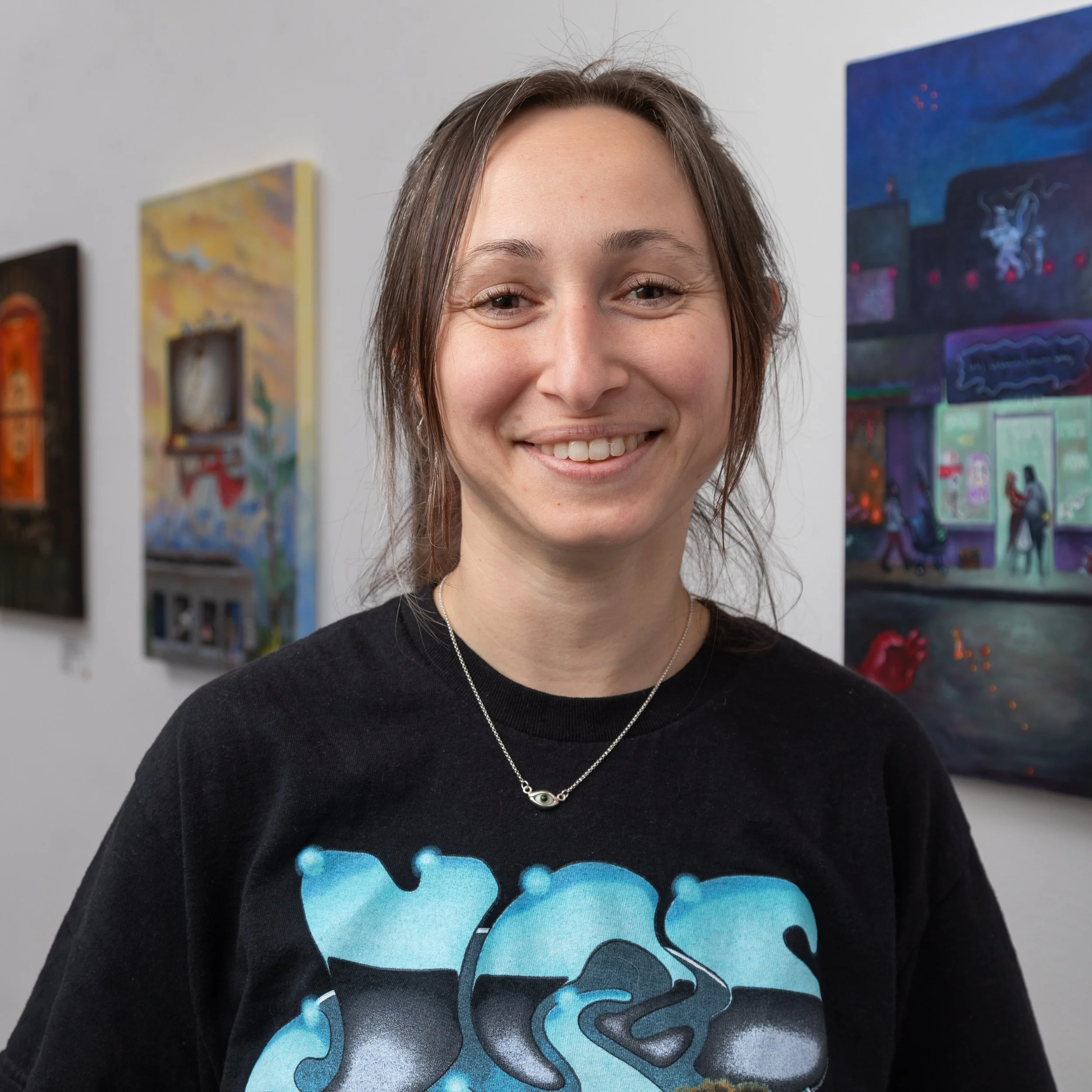Just A Moment: An Interview with Neena Holzman
By John Vochatzer
Featuring Photography By David Schmitz
Something I have always enjoyed is playing tour guide to friends or friends-of-friends visiting San Francisco for the first time. It gives me the chance to see the city through fresh eyes and recapture some of the enchantment I felt when I first moved here over 20 years ago. Neena Holzman’s work evokes a similar sensation for me. Looking at her pieces feels like being guided through San Francisco and the world by a very curious mind, one infused with both a childlike sense of wonder and yet possessing a mature ability to visually articulate the fascinations surrounding us—and of which many of us have become unfortunately numb to.
Her current solo exhibition, “Just A Moment,” running through December 2024 and January 2025, encapsulates this premise in perhaps its fullest realization to date. Featuring 26 new acrylic paintings, mostly created in 2024, the exhibit delivers exactly what the title suggests: a series of fleeting, seemingly unconnected moments bridged together by Neena’s eye for the magic of the everyday and her penchant for savoring the exquisite and often overlooked details peppered throughout urban scenery. Coming from a family of filmmakers, Neena’s work also feels feels very cinematic in essence, her paintings even perhaps resembling still frames that exist within larger untold narratives. Her day job as a theater set painter reveals itself in the lavish and occasionally fantastical backgrounds of her pieces.
Beyond the pleasure of being surrounded by this absorbing and evocative body of work for two months, I’ve greatly enjoyed the opportunity it’s given me to learn more about Neena’s influences and inspirations. From the technicolor backdrops of old films, to children’s dinosaur books, to the portraiture of George Grosz and Otto Dix— her wide well of interests blend seamlessly into her scenes without ever feeling too direct or derivative. This fusion is a refreshing affirmation and a reminder of how the art, films, music, and literature we consume can concretely shape how we perceive and experience the world around us.
Lastly, my only complaint about “Just A Moment” is that it leaves me longing for more. It’s like finishing a captivating novel or TV series and that feeling of bittersweet melancholy when it ends. The consolation, however, is that the work can linger indefinitely in the imagination, allowing the periphery of others’ visions and fantasies to grow and take shape in one’s own. This has already begun happening for me with Neena’s work; as I walk through San Francisco, I now often find myself coming across scenes and thinking, “I could imagine this in one of Neena’s paintings.”
“Liquid Experience,” Acrylic on Canvas. 18”x24”. 2024.
Interview
Hey Neena! Can you start by sharing a little about yourself and the work you do?
Hi John! I was born in New York and grew up in San Francisco. The first piece of art I remember loving was “Dogs Playing Poker” by Cassius Marcellus Coolidge. It’s a painting of anthropomorphized dogs commissioned to sell cigars in the 1800’s. My grandparents had a black and white print of it hanging in their bedroom. My great grandpa worked at his brother’s pawn shop in Long Island and it was from there.
My parents are filmmakers so I grew up watching a lot of older movies. The background paintings in Hollywood movies, especially the Technicolor ones, were what I spent the most time looking at.
My work has a lot to do with both the dogs and the matte paintings.
What’s your background as an artist? Did you pursue formal training in painting, or are you self-taught? And how long have you been painting or making art?
I drew a lot as a kid, mostly because I was quiet. As I got older, my parents supported me in developing it as a skill. I was lucky to have many great art teachers. One of my first teachers was a Concept Art student at Academy of Art University who babysat my brother and I. He was very into Star Wars and pirating movies on Lime Wire. The lessons focused on observation and realism- he would teach me how to paint planets so they glowed or get the highlight glistening on an eyeball. The goal of rendering something realistically was exciting to me. Thinking about it now, maybe it’s because a lot of my art making was motivated by a desire to work in movies as a matte painter and I wanted my work to be able to blend into reality.
I got my BFA from CCA’s INDI program in 2016 - my concentration was in printmaking, comics and painting.
Can you tell us about the paintings featured in Just A Moment? What was the main vision or inspiration behind this collection?
In recent years, most of my paintings have been of city streets in San Francisco but I had a very hard time picking what I would paint, or why. Over the summer I spent a lot of time alone at home working, listening to music. The times I did go out, I got this overwhelming feeling of excitement when I would look into corner stores, or see red lights twinkling in a bar window or look across the street at some drama unfolding. This felt like a type of friendship and it clicked to me that these moments were reason enough to make a painting.
It was cool to learn about some of your wide array of influences as an artist– ranging from Zap Comix to Pieter Bruegel the Elder and the Dutch Renaissance. Could you dive deeper into how these influences shape your painting style?
Both underground comix and Bruegel take a dark, humorous and bawdy approach to rendering life. That, among other things, caught my attention as a child. It must have stuck with me as an adult because humor is the only way I know how to approach a painting. Any attempt I make to be serious at the beginning is usually doomed. I think having a smile, laughter or even disgust as a reaction justifies the making of the painting to me. That’s probably something I need to get over.
I love Bruegel because his paintings are still yet we are witnessing the passage of time. Both within the narrative of the painting and on a more meta level as a modern audience. When I see his paintings I’m amazed how similar people are in their expressions, preoccupations, follies. Everything has changed and nothing has changed. His paintings have this apparent contradiction of being both incredibly tied to a specific place/culture/time and yet timeless.
“Sunset Billboard,” Acrylic on Canvas. 20”x16”. 2024.
As for underground comix, their use of autobiography provided inspiration and an easy way into making art as a teenager. What has stuck with me is their execution on a technical level. The expressiveness of the characters and the quality of line work -liquid, psychedelia mixed with excellent draughtsmanship. It was a tone and texture that reflected how living in a city felt to me.
Your work often focuses on the urban landscapes of San Francisco. What’s your relationship with the city, both personally and artistically?
The art I saw as a teenager while walking around SF really shaped me. In particular Little Eddie’s paintings and Lone Star Swan’s poetry pages. I admired these artists from afar but one day it occurred to me I could talk with them and maybe even buy their art. The whale mural at the O'Farrell Theater and the faux castle facade of Market Street Cinema also left a mark on me.
I know San Francisco has really shaped me as a person, especially in how I see, but I’m still figuring exactly what that means. It feels like part of the project of life to discover how the environment of your youth focuses your vision and directs your actions. At the beginning of City of Quartz Mike Davis quotes Walter Benjamin as saying “a native’s book about his city will always be related to memoirs; the writer has not spent his childhood there in vain” and somehow that captures a phenomena I have a very hard time describing.
"Mission Street Halloween", Acrylic on Canvas. 20”x16”. 2024.
While much of your work centers on San Francisco, Los Angeles makes a few cameos in this collection. Can you share more about those LA-inspired pieces and how you view the city artistically compared to SF?
I lived in Los Angeles from 2010-2012. I moved there to go to USC Roski School. My friend Eli and I would ride bikes downtown and go late night to the Original Pantry on Figueroa which had a big sign bragging “WE NEVER CLOSE”. The buildings downtown fascinated me. They had a psychic charge to them. I started reading about the history of the buildings and the lives that had passed through them. I would talk with people in the neighborhood too. I loved the facts but the rumors and tall tales were just as important and real to me. At that time, I bought a paper back copy of “Slouching Towards Bethlehem” which was inscribed “the future always looks good from the golden land because no one remembers the past” and this stayed with me. At the time it never occurred to me that I would want to draw or paint it. Los Angeles is the city that made me love cities and oddly enough, walking. I hope to go back there soon and do some paintings.
What’s your process for composing a painting? Do you primarily work from photographs? And how does a painting evolve from initial concept to finished piece?
Each painting is different but when I’m out I use my phone to take photos. I have an iPhone SE and the photos are good but a lot of detail gets lost, especially at night. If I see something or someone I want to paint I’ll write a description in my notes app because the photos I take are very flat and loose life. From there I’ll do sketches, sometimes on paper and sometimes on Procreate. I try and get the “statement” feeling right. I ask myself, what is it about the scene that drew me in and is how I’m composing the picture true to that idea? If it’s not I need to change things otherwise I’ll be fighting against it the whole painting. Then I go straight into painting. The building/landscape is the first thing that gets put down. I work with thin layers of acrylic paint and just keep adding more. Kind of like oils I guess. The details come last. I used to start with the details but this would usually end in a frustrating mess. I need a good foundation.
“Exhaust,” Acrylic on Canvas. 12”x16”. 2024
Another notable element of your work is its focus on nighttime or dusk settings. What draws you to these times of day, and how do they shape the scenes you depict?
My teacher and family friend Richard Olsen was the art teacher at Gateway High School. When I was little I’d hear about a legendary class he taught that happened in the middle of the night. The students would walk around the Tenderloin, take a midnight ferry, have a bonfire at Ocean Beach. In his statement for the class he describes the contrast between the majesty of the night of our ancestors and how in post modern/post industrial society, night has in many ways become an extension of the day. Yet, night still somehow retains it’s original grandeur. I think this is why I love night so much and why many other people do too.
“Zam Zam,” Acrylic on Canvas. 18”x14”. 2024.
Perhaps the most common word I’ve heard used to describe your work is “magical,” and often pointing to a sense of finding magic in the everyday. How do you feel about this description, and how does your view of the world around you translate into your art?
That’s a really kind thing of people to say. It’s interesting to me because I don’t think about magic very much. I do think that when something about the everyday jumps out at you, it’s the meeting between your imagination and the outside and one of the great joys and mysteries of life. Kenneth Anger said there’s two magics - rabbit in the hat and Magik with a “k”. I’ve always been more interested in the rabbit in the hat.
On top of your fine art, you’re also a theater set painter. Could you tell us more about that work? Does it inform or intersect with your studio practice?
I think of my personal art and my work as a scenic painter as being kind of indistinguishable.
Scenic painting has taught me to aspire to a balance of method and mess. All treatments need to be able to be done by anybody who comes into the shop. Being able to plan out your process and share it through creating samples, making color recipes, taking notes on the tools and application method - it might be the most important part of the job. When I first started scenic painting, I became aware that I was not used to thinking methodically as an artist. So working in a scenic shop really helped me experiment in my own work, try new techniques and carefully consider the order I do things in.
Painting with a lot of expressive mess is another really important part of scenic. The audience is seeing the set from far away so you need to keep their eye moving with slight changes in color, texture etc. It needs to be very expressive or else it will seem terribly flat. I use this a lot in my own painting. Any flat surface with nothing on it, say a wall or a sidewalk, is basically an opportunity to make an abstract painting.
Finally, what’s next for you? And how do you see your work evolving in the future?
Painting up until this point has been very solitary for me. I feel like I’m kind of standing outside of it all. I would like to get closer to whatever or whoever the subject is, maybe with portrait painting or by painting more personal and less public spaces. I also want to explore new places, I’ve been thinking of taking a train trip across the country and painting cities and towns along the way. Children’s books are a big inspiration to me and so one of my longer term goals is to make one, either on my own or in collaboration with friends.













